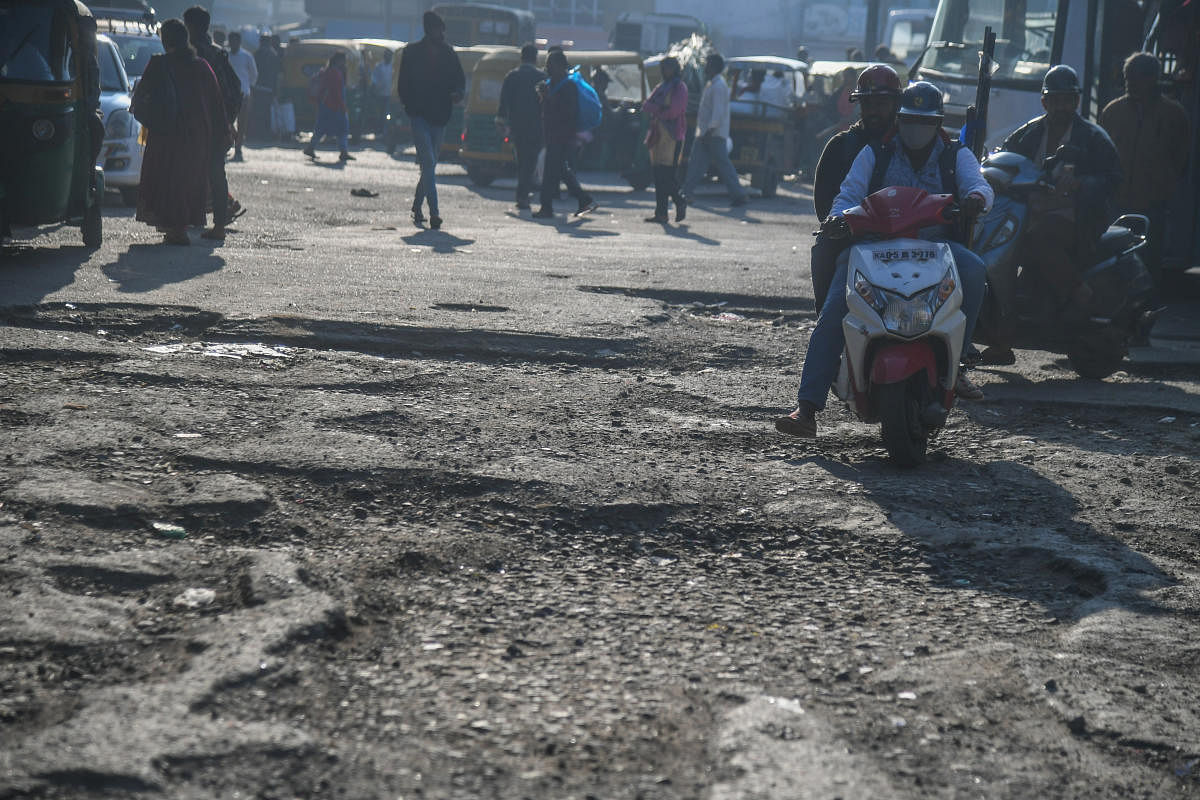
A year has passed since Anandappa S, a 46-year-old technician from Dasarahalli, was killed after his two-wheeler rammed temporary barricades, placed around a pit that was dug to fix a leaking water pipeline, on Hesaraghatta Main Road. He was the only earning member of the family. His wife and two daughters are struggling to make ends meet.
Relatives said that the family knocked on the doors of the BWSSB and the BBMP for compensation, but the authorities refused to help. Anandappa, they say, would not have died had the BWSSB not left the dug and poorly-lit road unattended. This, however, is not an isolated story.
From keeping the potholes and the dug-up pits unattended for long to showing a lack of urgency in fixing defective streetlights, administrative laxity is making a safe commute in Bengaluru increasingly dangerous. While rash driving adds to the problem, the unregulated spike in the number of personal vehicles – seen as a direct result of poor public transport coverage – also contributes to the number of accidents.
Till September 2022, Bengaluru reported 562 deaths in road accidents. The yearly number of deaths varied from 610 to 740 over the last 10 years. Outer Ring Road, Ballari Road and Hosur Road, which are used by a large number of Bengalureans, feature on the top of the list with the highest frequency of accidents in the city.
63 blackspots
As per the police records, there are a total of 63 accident blackspots across the city. A blackspot, according to the Ministry of Road Traffic and Highways, is defined as a stretch of road (about 500 metres) in which either five fatal accidents or 10 non-grievous accidents have been reported in the last three years.
City Traffic Police say the accident blackspots have retained the risk factor despite several corrective measures. “From identifying the problems to providing solutions, a lot gets done to fix the blackspots. What we have seen is that the accident spots keep changing,” B R Ravikanthe Gowda, Joint Commissioner (Traffic) told DH.
DH also spoke with senior police officers from different traffic jurisdictions where the blackspots are in big numbers. Traffic Police officials said that motorists slowing down to view Jakkur Aerodrome has led to accidents on the Ballari Road. On the Hosur Road, higher movement of pedestrians and speeding vehicles are the major contributing factors to the accidents, the police said.
“We had reported accident-related deaths at the circle where vehicles on the Old Madras Road meet vehicles coming from Indiranagar. After such instances, we kept the signal lights on even at night. Rumble strips have also been fixed. This has brought down the number of accidents,” a traffic police personnel attached to the Indiranagar station said.
He added that similar interventions made near the Command Hospital on Old Airport Road have not helped, due to the road gradient.
Ravikanthe Gowda said that the city traffic police would soon be procuring a laser-based contactless speed enforcement system. “This equipment will help the police in penalising motorists who are overspeeding. One such piece of equipment will be given to each traffic police station,” he said.
Holistic approach
Chetan Sodaye, a senior urban designer at research organisation WRI India, said the city must look at a more holistic and systematic approach to improve road safety.
“World over, countries are reducing traffic crashes by adopting the safe systems approach. It stems from the idea that no loss of life due to road traffic crashes should be acceptable. Safe systems approach hinges on the principle that the responsibility of road safety needs to be shared by policymakers, enforcement officials, urban designers, engineers, administrators, and road users,” he said.
Speed plan
Bengaluru, he added, reports a very high number of crashes due to speeding. “We need to urgently create a speed management plan. Only setting speed limits on urban roads will not work. It also needs to be supported with safe infrastructure. This will ensure that the speed limits are adhered to, making the streets safer by design,” he explained.
There, however, is a lack of seriousness among authorities when it comes to implementing measures for road safety. The Karnataka Road Safety Authority shot off two separate letters to the BBMP, one to fix potholes on a war-footing basis and another to clear hazardous materials blocking the roads. “Neither of the letters found a response,” Gnanendra Kumar, additional commissioner of the Authority, said.
He said that the United Nations had set a target of reducing the number of fatal accidents by half by 2030.
“As per the Supreme Court’s direction, the district road safety committee headed by the deputy commissioner is expected to review road safety issues on a monthly basis. No such meetings have happened so far,” he said.